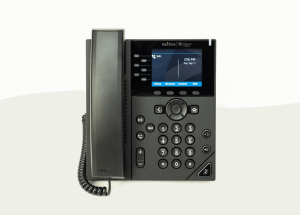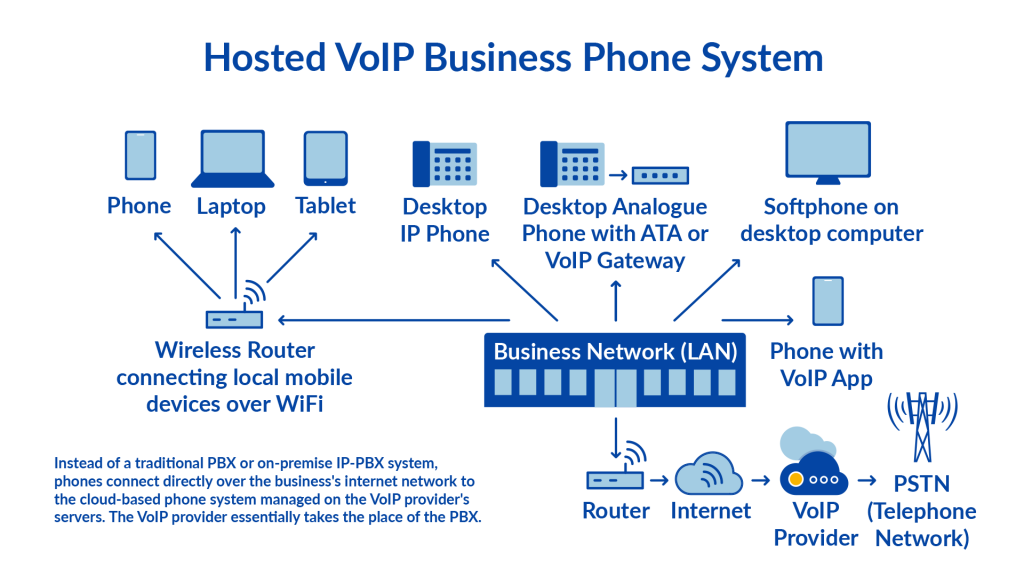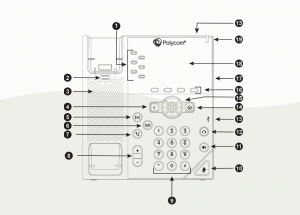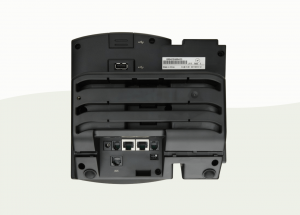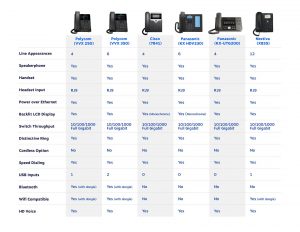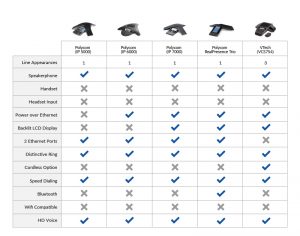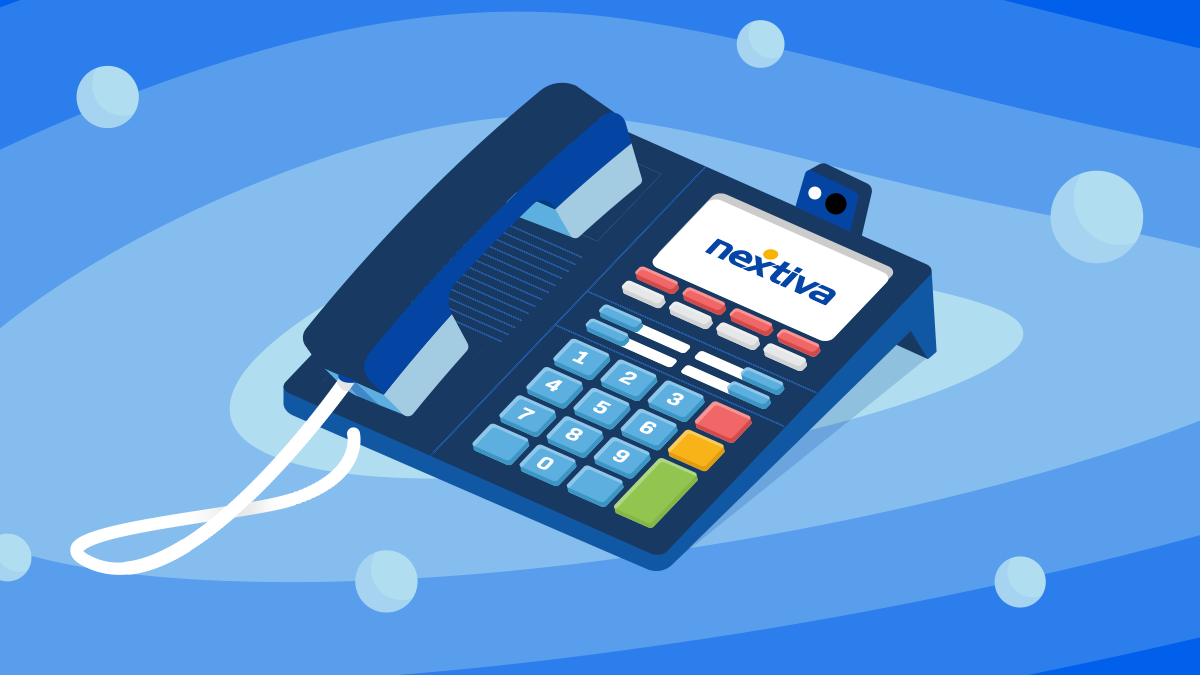
What is a VoIP Phone?
A VoIP phone is any phone that makes and receives calls using the internet. Instead of a traditional “hard wired” phone that uses direct connect copper wires to provide telephone service, A VoIP phone give you greater mobility, interoperability, and connectivity.
There are two big differences between VoIP phones and traditional phones. The first is that a VoIP phone will work no matter where you are. As long as you have internet, you’ll be able to make and receive calls without being tied to one place. And the second difference is that you technically don’t even need a phone to make calls. You can make a call from an app on your computer.
What are the benefits of a VoIP Phone?
There are many key features of VoIP that can help streamline your business, including:
- Easy install and setup
- Easy scaling
- Virtual phone numbers that follow you and your employees
- The technology supports older technology
- Wide availability and economical implementation
- Simple integration with other software applications.
- Range of device options
- Seamless set up on existing internet connections
Types of VoIP Phones
VoIP Hard Phones
Hard phones are like traditional phones in that they sit on your desk or in a conference room. You can use hard phones for:
- Direct calls
- Conference calls
- Accessing voicemail
- Communications through handsets, headsets, Bluetooth, and speakerphones
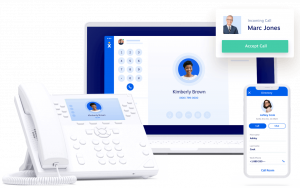
VoIP Softphones
Softphones are virtual phones that live in an app on a device (such as a computer, tablet, or smartphone). They work just like a hard phone, but rather than a physical phone, you make calls from an app.
How VoIP Phones Work
In the past, phones were wired to an on-premises Private Branch Exchange (PBX). This bulky machine would handle all routing and ensure each call reached its proper destination. VoIP phone features far exceed those available on old PBX systems.
Since VoIP phones work by processing telephone calls from the internet, or the cloud, the technology employs existing computer network cabling or Wi-Fi to access telephone networks.
No more wires or boxes needed to use your VoIP business phone service! Now you can take a call from anywhere you have internet — even from an app on your computer — and your phone number can stay the same as before, so there is no expense in changing it.
So whichever telephone device your company chooses, you can connect it to the VoIP phone system simply and easily. Just plug the phones in and have your tech team configure the system in a way that best suits your particular needs.
If you use a VoIP phone system from Nextiva, you’re using the best business phone service available today.
Related: 7 Steps to Set Up a VoIP Phone System at Home or the Office
What are the benefits of a VoIP Phone?
Many of the features of a VoIP phone service speak for themselves:
- Easy installation and setup on existing internet connections.
- Virtual phone numbers that follow you and your employees.
- Use your existing Internet connection. Other business phones require dedicated copper wiring separate from the computer network connection.
- Link to user accounts or to phone numbers. They allow you to switch between simultaneous calls on a given account.
- Simple integration with other software applications, like Microsoft Teams
- Give companies easy access to advanced voicemail features.
- Higher quality audio range (twice that of traditional).
- Can be set up for PoE. That means they get power over their Ethernet network cable instead of a traditional power adapter. This results in fewer transformers having to be plugged into power strips around the office.
VoIP Phone Features
Now let’s look at a typical VoIP phone and examine its functions and features. This is a general description, but we will use a diagram of a Poly phone. So the specific functions and button locations will differ slightly with other models.
You will need to understand the wide range of options to make the best choice for your business.
1) Line keys
- Usually these buttons light up to remind you when there is a call waiting or parked on that line.
- An easy way to identify the number of lines available on this phone, count these buttons.
- Often these buttons can also be programmed with speed dial access to your important clients.
2) Reversible Tab
Flips over into a hook allowing you to rest the phone on a wall without the handset falling off.
3) Speaker
Where the sound comes from when in speakerphone mode. The quality of a phone’s speaker is important for effective communication.
4) Back Key
Allows you to return to the previous menu at the push of a single button.
5) Transfer Key
Allows you to send the caller to another user’s phone.
- Different from call forwarding in that it is designed to be used after someone has answered the phone.
- Warm Transfer – allows you to have caller hold while you check the destination number recipient.
- Blind Transfer – allows you to send the call over to the new device without first checking if they will answer.
6) Messages
This button gives you quick access to your waiting voicemail.
- Sends you to your voicemail where you can get access to all the advanced features of VoIP voicemail.
7) Hold
Similar function to the hold buttons we all know and love.
8) Volume keys
Up = louder, down = softer
9) Dial pad
The standard number arrangement used for dialing.
10) Mute key
Used to mute the microphone so a quick confidential comment can be made, or if you want to make an espresso during a conference call.
11) Speakerphone key
Impromptu conference calls and hands free so you can multitask.
12) Headset key
Switch to your headset if equipped.
13) USB Port
Allows you to use a USB headset or plug in a flash drive.
14) Home key
Sometimes as you search through the options on your phone, you will need a shortcut to go back to the beginning.
15) Navigation keys/select key
Use these to navigate the display, like a mouse or joystick.
- Directions correspond to the on-screen menus: up/down to scroll through contacts, left/right to choose options like a ring type for each contact, etc.
16) Soft keys
These keys will change function based on the context of what you are currently doing. Usually the display will tell you what it can do for you.
Here is a list of generally available options you might see on the display for the soft key.
These options are displayed when the phone is active (when the phone is off the hook or engaged in a call).
- Transfer
- Blind Transfer
- Conference
- Park
- Redial
- Directory
- Speed Dial
These are displayed when the phone is idle (when the phone is on the hook).
- Redial
- Directory
- Call Pickup
- Call Forward Activate / Deactivate
- Do Not Disturb
- Last Call Received
- Missed Calls
- Speed Dial
- Soft keys are dynamic. They can be programmed to do different functions if you’re on a call vs if the call is idle
17) Security Slot
Enables you to attach a security cable and lock the device to a desk (on the reverse side of the phone).
18) Screen
This will vary between models; there are now many devices with full color touch screens.
- A VoIP phone screen usually shows all the info the user needs. This can include things like time, date, soft keys, global messaging, parked calls, etc. (Everything the phone thinks you want to know.)
- Higher-end phones employ touch screens like smartphones that can replace some or all the buttons on the device.
19) Message waiting indicator
A simple light to let you know “You’ve got mail”
Related: 12 VoIP Blogs to Bookmark (News, Trends, and More)
Phone Setup
Instead of the 6-pin RJ-11 phone connectors, VoIP phones plug into 8-pin RJ-45 jacks. These RJ numbers are not droid names but are actually the connectors your computer uses to connect to the internet.
Both the RJ-11 and RJ-45 look very similar. To the average person, these connectors would simply be called ‘phone jacks’ or ‘ethernet cables’. But in reality, they serve two different purposes.
The RJ-11 is designed to connect analog phones, while the RJ-45 is designed to connect networks. To learn more about the difference between analog and VoIP, read our blog post on VoIP vs. PSTN.
Most VoIP phones need only a network connection or router. Some newer models might not need cables at all and can connect to your network simply through WiFi.
Look at this phone’s bottom! No mystery here. Plug in the network cord, power jack, and you’re done!
Now the bonus. Take a look at the second port. You can plug in another phone and chain two phones together on the same network wall jack. This means you won’t have to deal with messy, big bundles of cables running to routers under your desk.
Make sure you use the correct cables, though, so that you can get adequate connection speeds.
For exact specifications on the different cables available, refer to the chart below.
Network Cable Specification Comparison
| Specification | Cat-5 | Cat-5e | Cat-6 | Cat-6a | Cat-7 |
|---|---|---|---|---|---|
| Frequency | 100 MHz | 100 MHz | 250 MHz | 500 MHz | 600 MHz |
| Attenuation | 24 dB | 24 dB | 19.8 dB | 18.4 dB | 20.8 dB |
| Impedance | 100 ohms ±15 | 100 ohms ±15 | 100 ohms ±15 | 100 ohms ±15 | 100 ohms ±15 |
| NEXT | 27.1 dB | 30.1 dB | 44.3 dB | 59 dB | 62.1 dB |
| PS-NEXT | N/A | 27.1 dB | 42.3 dB | 59.1 dB | 59.1 dB |
| ELFEXT | 17.9 dB | 17.4 dB | 27.8 dB | 43.1 dB | Not Specified |
| PS-ELFEXT | 14.4 dB | 14.4 dB | 24.8 dB | 41.8 dB | Not Specified |
| Return Loss | 16 dB | 20.1 dB | 20.1 dB | 32 dB | 14.1 dB |
| Delay Skew | 50 ns | 45 ns | 45 ns | 45 ns | 20 ns |
It was a widespread practice to use old standard CAT-5 cables when the computer revolution began, but now those older cables can’t handle faster speeds. Upgrading to a minimum of CAT-5e—or better yet CAT-6—will fix this.
Read the category designation on the side of the cable to find out if your cables and jumpers are adequate for your current infrastructure.
Compare VoIP Phones
Now that you better understand both how VoIP works and what they can do to improve your business communications it’s time to select a phone model.
This can often become a daunting task when you realize that there are hundreds of devices to choose from and more than a dozen brands.
To make the decision process easy, Nextiva has assembled a chart showing the most popular phones on the market. All of these models have been tested and reviewed, and each has benchmarked to the highest industry standards.
Remember, though, that there are countless other models available (some with either more advanced features or additional lines). Here’s a more comprehensive list of the best business VoIP phones.
Note that if you need a business conference phone it will be handled in the next section.
Video review of the Nextiva X-885
Compare VoIP Conference Phones
A conference phone differs from a desktop phone in that it is optimized for both hearing and sending the best quality audio in a group setting (like a conference room table).
Conference phones are designed with omni-directional microphone configuration.
However, there isn’t a big functional difference between a desktop phone and a conference phone. If you learn how to use one, you can easily use the other.
The models shown below are among the most popular in the market. Each comes with standard features like speakerphones and speed dialing. For information on additional features and capabilities, refer to the chart below.
What type of VoIP phone does my business need?
In the end, you cannot go wrong with any of these popular devices. You’ll notice that each of these offers the features that you would expect from a phone system.
Here are the primary requirements to consider before choosing a device:
- Look at the brands. Are there names you trust more than others? Think about longevity and past performance.
- Poly is the global leader when it comes to productive and effective engagement with colleagues, partners, customers, and prospects. You can’t look at a serious VoIP solution without including their product line in your decision-making process.
- Cisco is the big name in business networks and internet infrastructure and another lead player in the VoIP hardware realm.
- Panasonic is one of the world’s leading innovators in VoIP phone business systems. Their reputation for making quality electronic devices goes back decades.
- VTech is the world’s largest manufacturer of cordless phones and well known for its electronic educational toys.
- Look for the number of line appearances. How many lines does each device in your business need to be able to handle? Some team members will need many more than two lines.
- Do you use headsets? What type of connector do they have? An RJ-9 is a familiar type of connector for telephones, but are less popular. Today’s headsets use USB for connectivity. If you need Bluetooth, then make sure your device supports it. Some devices require a USB-to-Bluetooth dongle that might not be included.
- Ready for Power over Ethernet (PoE)? Most devices now support for PoE, but ensure that you have the power adapters since most employees that work from home do not have PoE-capable network equipment.
- Don’t forget about reliability. Does the phone receive regular security updates? VoIP phones that receive these updates tend to provide much more reliable VoIP phone service than devices that need firmware delivered by hand. (Hint: Many, many internet-connected devices never get updated.)
Because VoIP conference phones have a slightly different purpose and function in the office, though, there are a few additional factors to consider regarding conference phones:
- Notice the option for going cordless. Many conference rooms don’t have a network jack in the middle of the table. If you want to avoid running another cable, this could be an important choice for your device.
- Bluetooth might be important too. Especially if you need to boost the sound for someone with a hearing impairment and not make it uncomfortably loud for others in the room.
- The display is further away from the user, so a brightly-lit readable display could make a difference.
- Importantly, take note of the reputation for quality that each brand represents and look at their customer service rating.
- Lastly, a coffee/espresso maker option is not yet available on any model. Perhaps we should start a write in campaign?
Conclusion
There are many choices when buying and configuring your business VoIP service. Making sure you have the best VoIP provider, phones, and features, gives you more confidence to run your business.
It doesn’t have to be hard. In fact, setting up a virtual phone system is so easy, you can set it up yourself.
The good news is that you are not alone in this journey, and there are professionals to guide you along the way. Let Nextiva’s VoIP specialists help you select the perfect phone system for your company. Also, check out what our customers say about our VoIP phone service.
We’ve done the research for you. Download the VoIP Phone System Buyer’s Guide loaded with proven best practices.

Cameron Johnson is a market segment leader at Nextiva. Along with his articles on Nextiva’s blog, Cameron has written for a variety of publications including Inc. and Business.com. Cameron was recently recognized as Utah’s Marketer of the Year.
